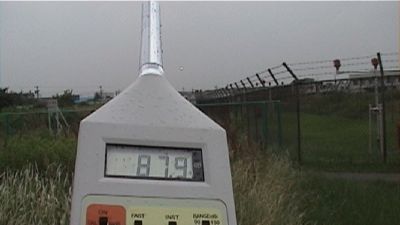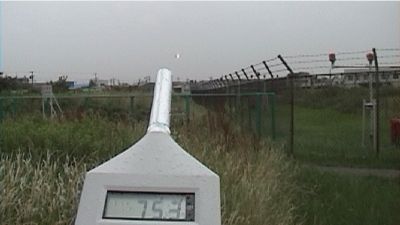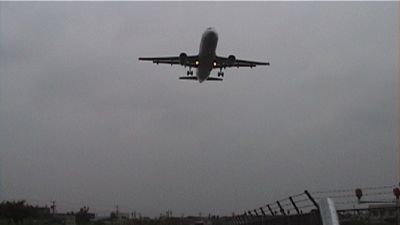| Japanese | English |

| 1 | Microphone | 1/2-inch electret condenser microphone. |
| 2 | Display | Measurement
result, over-scale, under-scale, and battery life are displayed. Levels are shown with 0.1-dB resolution. "OVER" means measurement range is too low. "-" means measurement range is too high. "BATT" means the battery is low. |
| 3 | Range switch | Switches
between measurement ranges. Range is set to 60-100 for calibration (CAL). |
| 4 | Function switch | Switches between A and C frequency weighting for approximating the human ear sensitivity to different SPL ranges. |
| 5 | Calibration volume | Adjust to 94.0 dB for calibration (range is 60-100 dB). |
| 6 | External power connection terminal | Connects to AC adapter (AC-1046, option). |
| 7 | AC output terminal | Outputs AC signal. |
| 8 | DC output terminal | Outputs DC level signal. |
| 9 | Reset switch | Resets the hold value. |
| 10 | Measurement mode switch | Switches
between INST and MAX HOLD. INST shows instant value. MAX HOLD shows maximum value. |
| 11 | Dynamic characteristic switch | Switches between two time constants, FAST/SLOW. |
| 12 | Power switch | Turns power ON and OFF, switches to calibration (CAL). |
|
Difference in measured value when target noise is being emitted and not being emitted (dB) |
4 - 5 | 6 - 9 |
| Corrected value (dB) | -2 | -1 |
Note
ACO's sound level meter has three measurement ranges. Maximum level of each range is 70, 100, and 130 dB and its dynamic range is 40 dB. If the dynamic range of sound to be measured exceeds 40 dB, it could not be measured correctly.
Aircraft noise was measured outside. Displayed level is not true. Because I did not change the measurement range correctly, measurement has become impossible.

When I changed the measurement range, sound level was about 76dBA.

Sound level above 100dB could not be measured.
